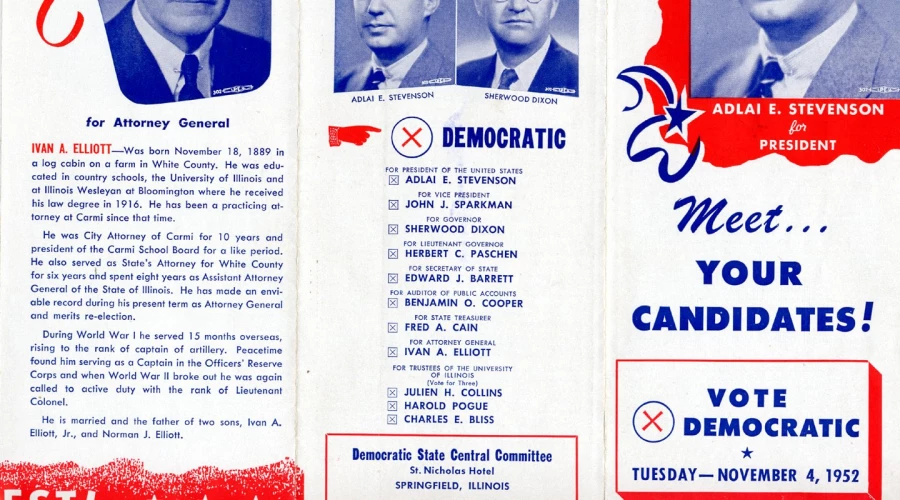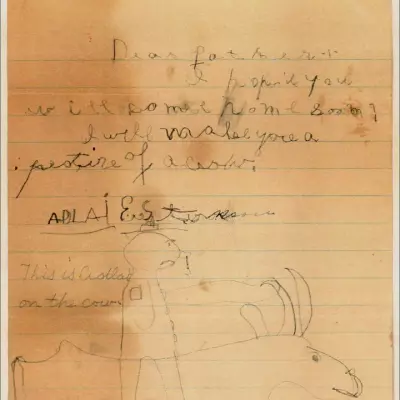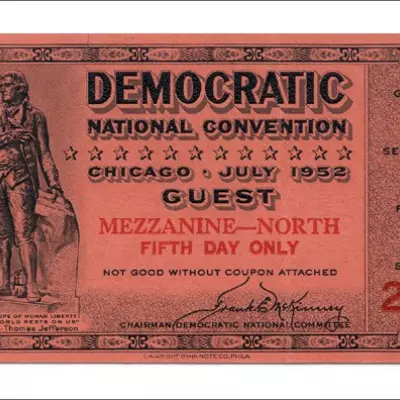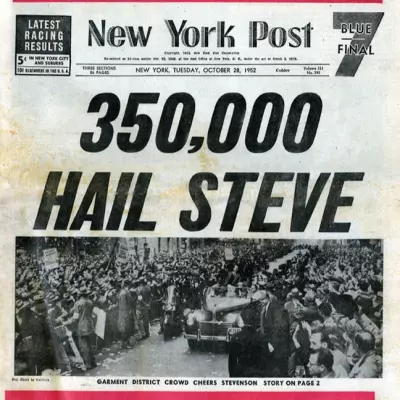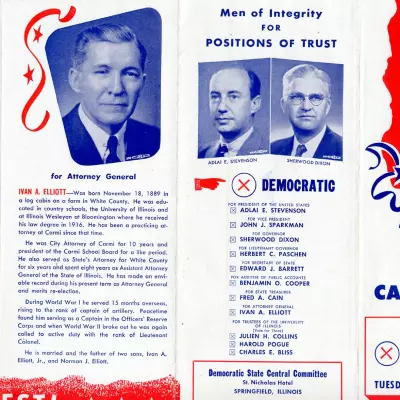Primary Sources
Primary sources (also called "original sources") are the records or traces of past events — documents and artifacts saved from earlier times — from which historians gather information for their research.
The name "primary" means that document or artifact was present "at the beginning," at the original time the event or circumstances took place. Accurate historical research begins with a careful reading or examination of primary sources.
Questions for thought: The use of primary sources relates well to Adlai Stevenson's core value of trusting people to THINK for themselves: "Trust the people, trust their good sense... Trust them with the facts...." Check the facts for yourself. Find some clues in primary sources: Read a speech. Look at a photograph. What does it tell you about the past? How can it help you understand the present?
Secondary Sources
A secondary source is a document or recording that discusses information originally presented elsewhere. A secondary source contrasts with a primary source — an original source of the information being discussed.
Secondary sources often involve generalization, analysis, synthesis, interpretation, or evaluation of primary source information. Historians classify the sources of historical writing to help determine the reliability and independence of a source. Since a secondary source is a record or statement made after an event, the fallibility of memory can be an important factor.
Shifts in public opinion and personal bias can also affect secondary sources, even for eye-witness accounts written long after an event. Thus many historians would advise that you "proceed with caution" when using secondary sources.
Examples: encyclopedia entries, research papers, monographs, biographies, history books and textbooks, movies, and plays.
Questions for thought: Is a newspaper article a primary or a secondary source? Why?
How to Examine Resources
When historians read and examine both primary and secondary sources, they apply their knowledge of history to analyze and interpret these sources.
Historians consider what else was going on at the time an event took place. What were the predominant influences? Has something similar ever happened before? History interpretations can be found in many places, such as museum exhibits, movies, plays, websites, books, magazines, and newspapers.
A search for Adlai Stevenson in Today's News demonstrates how news articles and editorials ("opinion" articles) are resources that come into existence on a daily basis.
Explore the following resources. Some include primary sources. Some are secondary sources.
Sample artifacts and documents
Primary source documents are documents that have been printed, handwritten, recorded, or digitized. They include letters, diaries, ledgers, recordings of speeches, newsreels, newspapers and photographs.
Primary source artifacts are any type of object from the time period, event, or circumstance: campaign buttons, clothing, household items, even buildings. An organized collection of primary sources on a particular subject is called an archive.
Click on the images in the collage to examine some sample digitized primary source documents and artifacts that relate to Adlai Stevenson (courtesy of the McLean County Museum of History archives).
Online Resources
The internet provides easy access to a wide variety of online resources.
Museums and Libraries
Museum and library websites offer online collections, archives, and exhibits.
The Adlai Archive section on this website offers digitized primary source documents. In the field of history research and preservation, digitization means the conversion or scanning of documents and artifacts into a digital form that can be stored on computer. Paper documents and photographs, as well as various media recordings, which have enduring historical or research value are being digitized by libraries, museums, and archives. The advantage of digitization is that unique documents and artifacts can be preserved and accessed by anyone anywhere.
Stevenson-related files, such as his 1952 and 1956 campaign ads, are available in the exhibit website, "A Voice of Conscience: The Legacy of Adlai Stevenson," at the Seeley G. Mudd Manuscript Library, Princeton University. This site also includes a detailed inventory of the Stevenson Papers, such as correspondence, speeches, writings, campaign materials, personal files, photographs, and audiovisual materials.
Adlai E. Stevenson Papers at Princeton University
"Stevenson Center on Democracy" The Adlai Stevenson Center on Democracy seeks to enhance the global understanding and practice of democracy.
Stevenson Center for Community and Economic Development
Good works continue in Stevenson's name. The Stevenson Center's mission is to promote public service. It includes graduate studies such as Peace Corps Fellows Program, which helps underserved rural and urban communities across the United States.
Smithsonian Institution, Washington, D.C. — Type "Adlai Stevenson" in the search box and view items in the museum's collections, such as Stevenson's briefcase while he was UN ambassador.
Search tools
Numerous search tools are available online.
Google News features modern and historical news articles referencing Adlai Stevenson.
Search for Stevenson campaign commercials, speeches, and related material on YouTube.
Stevenson was known for his sharp wit and good humor, and he remains one of the more quotable American politicians of the twentieth century.
Books
Books are a traditional resource for history research and personal enjoyment. Almost all research is cumulative.
This means that any particular project is built on a foundation of prior research. Secondary sources, such as books, can enable you to learn from and build upon the research of others. Secondary sources can offer generalization, analysis, synthesis, interpretation, or evaluation of primary sources.
Most history books are secondary sources, such as biographies and history textbooks. A few books offer collections of primary source documents.
If your school or local public library does not carry one or more of the following titles, you can usually obtain them through interlibrary loan. Ask your librarian for assistance.
Johnson, Walter, ed. The Papers of Adlai E. Stevenson. 8 vols. Boston: Little, Brown, 1972-79.
General Biographies
Broadwater, Jeff. Adlai Stevenson and American Politics: The Odyssey of a Cold War Liberal. New York: Twayne, 1994.
Davis, Kenneth S. The Politics of Honor: A Biography of Adlai E. Stevenson. New York: Putnam, 1967.
Martin, John Bartlow. Adlai Stevenson and the World: The Life of Adlai E. Stevenson. Garden City, New York: Doubleday, 1977.
McKeever, Porter. Adlai Stevenson: His Life and Legacy. New York: Morrow, 1989.
Whitman, Alden (with The New York Times). Adlai E. Stevenson: Politician, Diplomat, Friend. New York: Harper & Row, 1965.
Stevenson's Legacy
Liebling, Alvin, ed. Adlai Stevenson's Lasting Legacy. New York: Palgrave Macmillan, 2007.
Muller, Herbert J. Adlai Stevenson: A Study in Values. New York: Harper & Row, 1967.
Stevenson and the Stevenson Family
Baker, Jean H. The Stevensons: A Biography of an American Family. New York: W.W. Norton, 1996.
Ives, Elizabeth Stevenson (with Hildegarde Dolson). My Brother Adlai. New York: Morrow, 1956.
Doyle, Edward P. As We Knew Adlai. New York: Harper & Row, 1966.
As Illinois Governor
Busch, Noel F. Adlai E. Stevenson of Illinois. New York: Farrar, Straus & Young, 1952.
Harris, Patricia Milligan. Adlai, The Springfield Years. Nashville: Aurora Publishers, 1975.
Martin, John Bartlow. Adlai Stevenson of Illinois: The Life of Adlai E. Stevenson. Garden City, New York: Doubleday, 1976.
As UN Ambassador
Walton, Richard J. The Remnants of Power; the Tragic Last Years of Adlai Stevenson. New York:Coward-McCann, 1968.
Biographies for Junior High Students
Hayman, LeRoy. American Ambassador to the World: Adlai Stevenson. New York: Abelard-Schuman, 1966.
Levine, I.E. Spokesman for the Free World: Adlai E. Stevenson. New York, J. Messner, 1967.
Severn, Bill. Adlai Stevenson: Citizen of the World. New York: David McKay Co., 1966.
Ward, Martha Eads. Adlai Stevenson, Young Ambassador. New York: Bobbs-Merrill, 1967.
